Independent Study: PTSD Management for Ambulance Staff Review
VerifiedAdded on 2022/12/27
|33
|11284
|2
Report
AI Summary
This report is a literature review focusing on the management of Post-Traumatic Stress Disorder (PTSD) among frontline staff within the ambulance service. It begins with an introduction from a Locality Manager in an NHS Trust, highlighting increasing absences due to mental health issues like PTSD, stress, and depression. The review includes a glossary, sickness absence data, and a GANT chart to visually represent the project timeline. The methodology outlines the search strategy used to gather relevant literature, followed by the results presented in a PICO table. The analysis and discussion delve into the causes and effects of PTSD, examining the impact on ambulance personnel and the importance of early intervention. The conclusion summarizes key findings and suggests improvements for staff support. The report emphasizes the need for early recognition of symptoms, interventions, and support systems to minimize the impact of PTSD on staff wellbeing and reduce workplace absences. The document also references the Faculty of Health Studies Module Handbook for the Independent Study module HES6003-C at the University of Bradford.
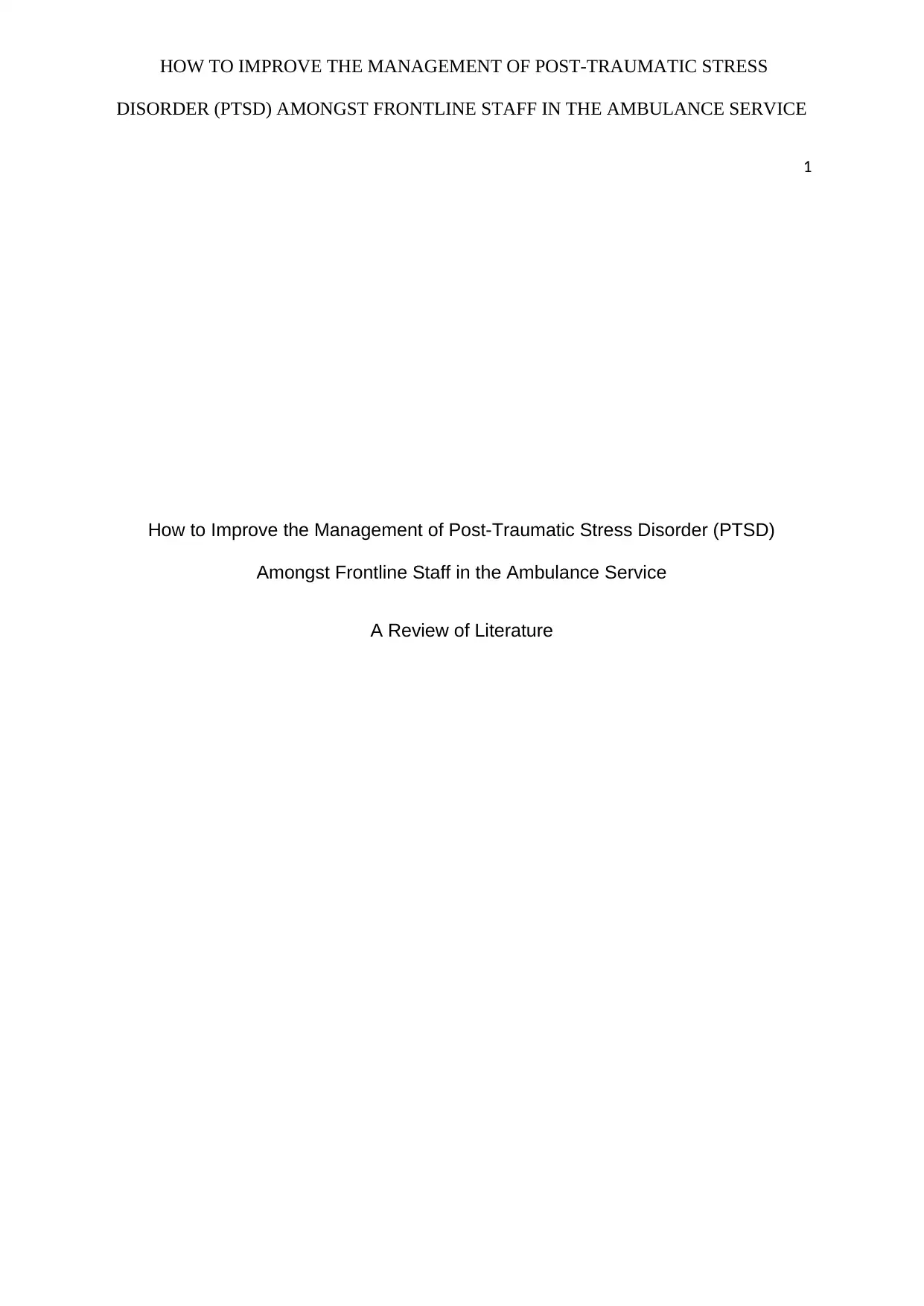
HOW TO IMPROVE THE MANAGEMENT OF POST-TRAUMATIC STRESS
DISORDER (PTSD) AMONGST FRONTLINE STAFF IN THE AMBULANCE SERVICE
1
How to Improve the Management of Post-Traumatic Stress Disorder (PTSD)
Amongst Frontline Staff in the Ambulance Service
A Review of Literature
DISORDER (PTSD) AMONGST FRONTLINE STAFF IN THE AMBULANCE SERVICE
1
How to Improve the Management of Post-Traumatic Stress Disorder (PTSD)
Amongst Frontline Staff in the Ambulance Service
A Review of Literature
Paraphrase This Document
Need a fresh take? Get an instant paraphrase of this document with our AI Paraphraser
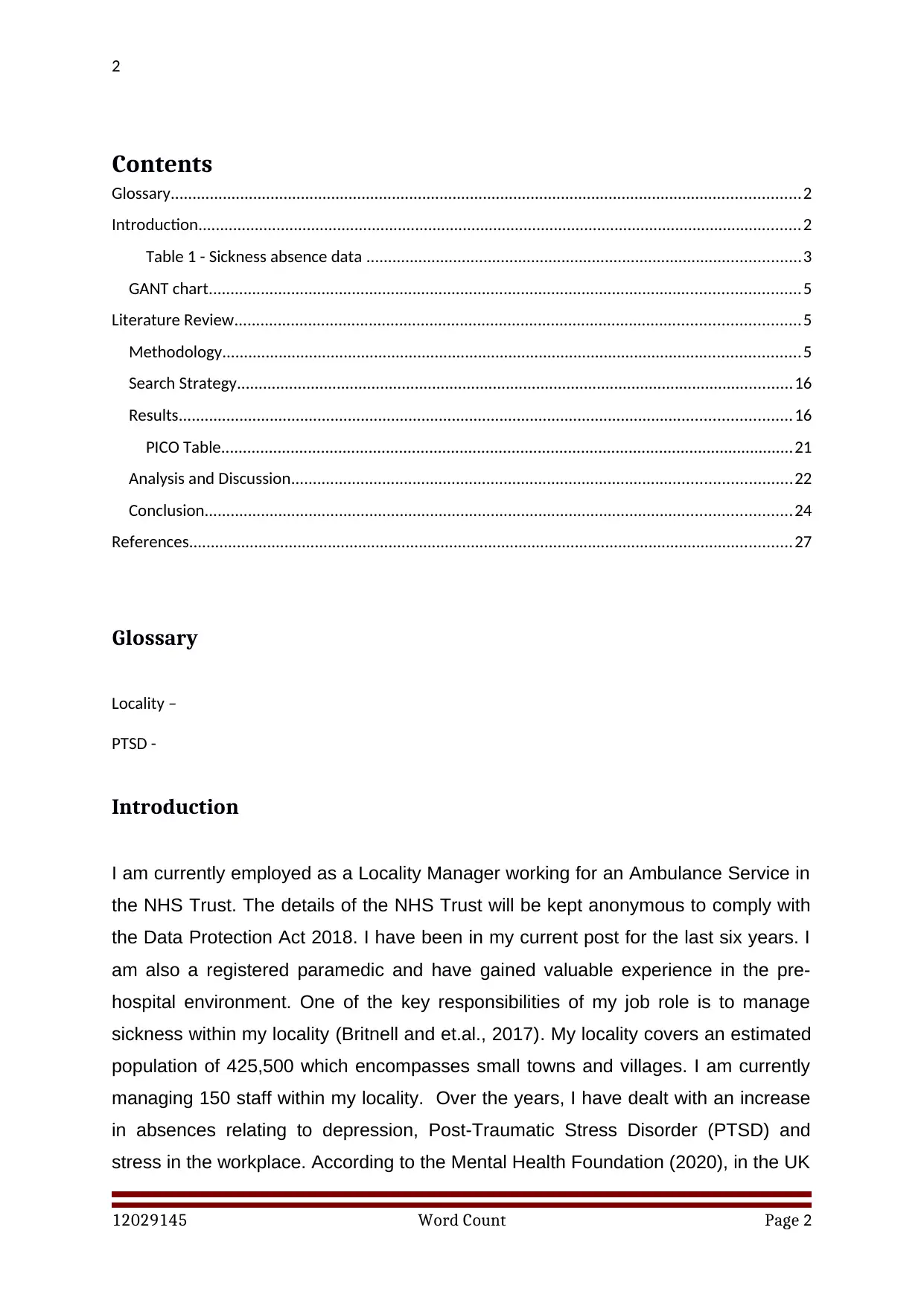
2
Contents
Glossary.................................................................................................................................................2
Introduction...........................................................................................................................................2
Table 1 - Sickness absence data ....................................................................................................3
GANT chart........................................................................................................................................5
Literature Review..................................................................................................................................5
Methodology.....................................................................................................................................5
Search Strategy................................................................................................................................16
Results.............................................................................................................................................16
PICO Table....................................................................................................................................21
Analysis and Discussion...................................................................................................................22
Conclusion.......................................................................................................................................24
References...........................................................................................................................................27
Glossary
Locality –
PTSD -
Introduction
I am currently employed as a Locality Manager working for an Ambulance Service in
the NHS Trust. The details of the NHS Trust will be kept anonymous to comply with
the Data Protection Act 2018. I have been in my current post for the last six years. I
am also a registered paramedic and have gained valuable experience in the pre-
hospital environment. One of the key responsibilities of my job role is to manage
sickness within my locality (Britnell and et.al., 2017). My locality covers an estimated
population of 425,500 which encompasses small towns and villages. I am currently
managing 150 staff within my locality. Over the years, I have dealt with an increase
in absences relating to depression, Post-Traumatic Stress Disorder (PTSD) and
stress in the workplace. According to the Mental Health Foundation (2020), in the UK
12029145 Word Count Page 2
Contents
Glossary.................................................................................................................................................2
Introduction...........................................................................................................................................2
Table 1 - Sickness absence data ....................................................................................................3
GANT chart........................................................................................................................................5
Literature Review..................................................................................................................................5
Methodology.....................................................................................................................................5
Search Strategy................................................................................................................................16
Results.............................................................................................................................................16
PICO Table....................................................................................................................................21
Analysis and Discussion...................................................................................................................22
Conclusion.......................................................................................................................................24
References...........................................................................................................................................27
Glossary
Locality –
PTSD -
Introduction
I am currently employed as a Locality Manager working for an Ambulance Service in
the NHS Trust. The details of the NHS Trust will be kept anonymous to comply with
the Data Protection Act 2018. I have been in my current post for the last six years. I
am also a registered paramedic and have gained valuable experience in the pre-
hospital environment. One of the key responsibilities of my job role is to manage
sickness within my locality (Britnell and et.al., 2017). My locality covers an estimated
population of 425,500 which encompasses small towns and villages. I am currently
managing 150 staff within my locality. Over the years, I have dealt with an increase
in absences relating to depression, Post-Traumatic Stress Disorder (PTSD) and
stress in the workplace. According to the Mental Health Foundation (2020), in the UK
12029145 Word Count Page 2
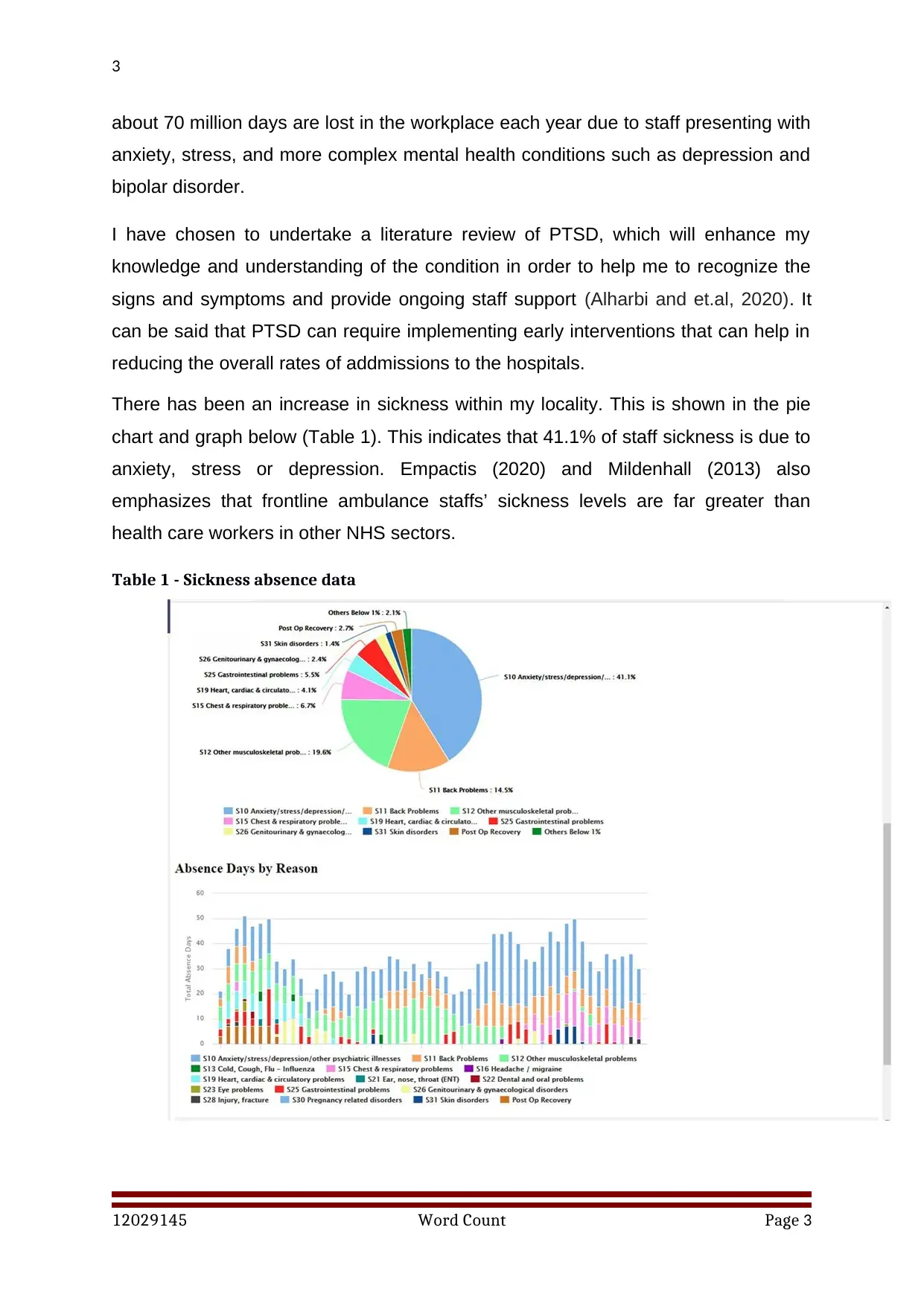
3
about 70 million days are lost in the workplace each year due to staff presenting with
anxiety, stress, and more complex mental health conditions such as depression and
bipolar disorder.
I have chosen to undertake a literature review of PTSD, which will enhance my
knowledge and understanding of the condition in order to help me to recognize the
signs and symptoms and provide ongoing staff support (Alharbi and et.al, 2020). It
can be said that PTSD can require implementing early interventions that can help in
reducing the overall rates of addmissions to the hospitals.
There has been an increase in sickness within my locality. This is shown in the pie
chart and graph below (Table 1). This indicates that 41.1% of staff sickness is due to
anxiety, stress or depression. Empactis (2020) and Mildenhall (2013) also
emphasizes that frontline ambulance staffs’ sickness levels are far greater than
health care workers in other NHS sectors.
Table 1 - Sickness absence data
12029145 Word Count Page 3
about 70 million days are lost in the workplace each year due to staff presenting with
anxiety, stress, and more complex mental health conditions such as depression and
bipolar disorder.
I have chosen to undertake a literature review of PTSD, which will enhance my
knowledge and understanding of the condition in order to help me to recognize the
signs and symptoms and provide ongoing staff support (Alharbi and et.al, 2020). It
can be said that PTSD can require implementing early interventions that can help in
reducing the overall rates of addmissions to the hospitals.
There has been an increase in sickness within my locality. This is shown in the pie
chart and graph below (Table 1). This indicates that 41.1% of staff sickness is due to
anxiety, stress or depression. Empactis (2020) and Mildenhall (2013) also
emphasizes that frontline ambulance staffs’ sickness levels are far greater than
health care workers in other NHS sectors.
Table 1 - Sickness absence data
12029145 Word Count Page 3
⊘ This is a preview!⊘
Do you want full access?
Subscribe today to unlock all pages.

Trusted by 1+ million students worldwide
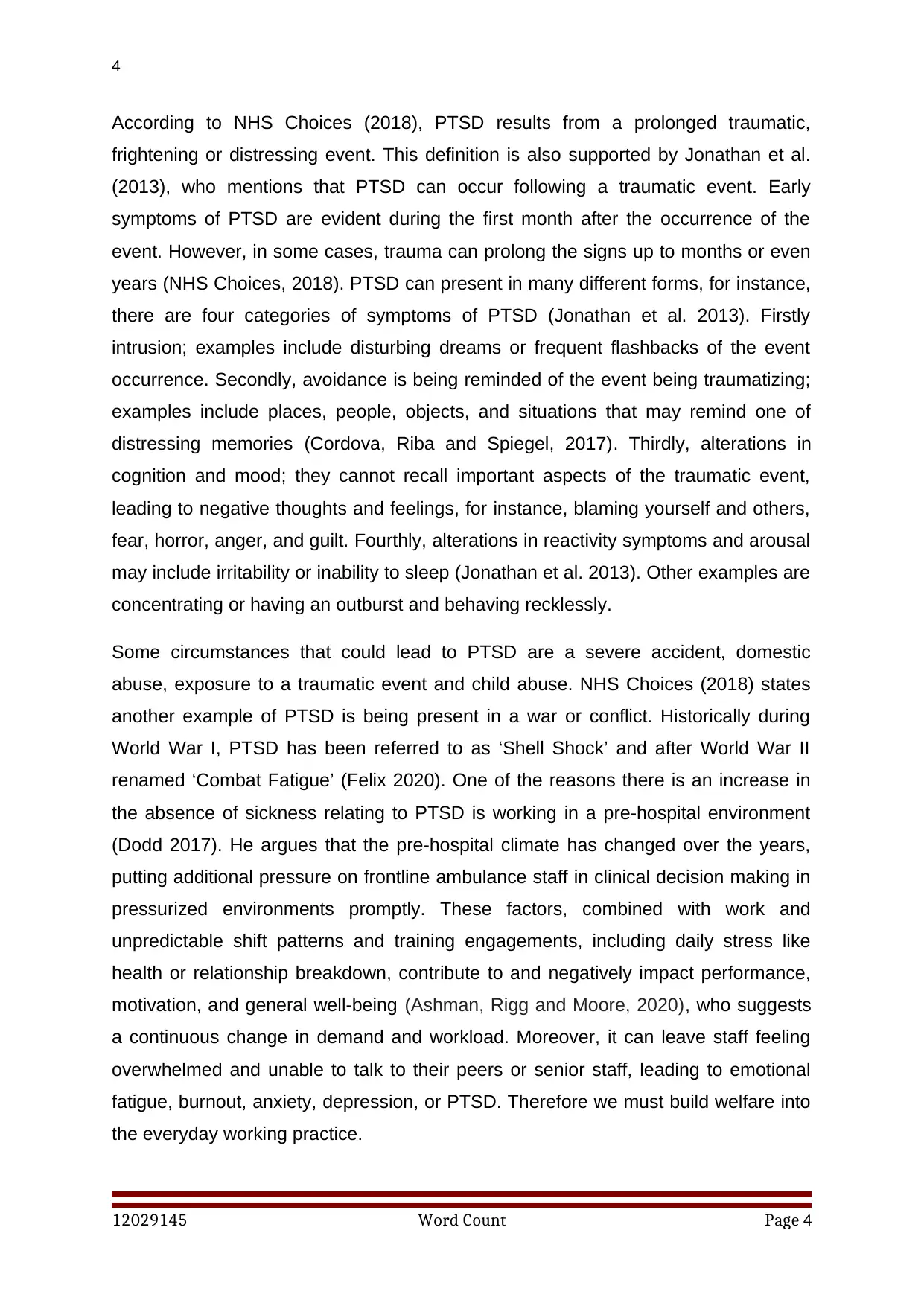
4
According to NHS Choices (2018), PTSD results from a prolonged traumatic,
frightening or distressing event. This definition is also supported by Jonathan et al.
(2013), who mentions that PTSD can occur following a traumatic event. Early
symptoms of PTSD are evident during the first month after the occurrence of the
event. However, in some cases, trauma can prolong the signs up to months or even
years (NHS Choices, 2018). PTSD can present in many different forms, for instance,
there are four categories of symptoms of PTSD (Jonathan et al. 2013). Firstly
intrusion; examples include disturbing dreams or frequent flashbacks of the event
occurrence. Secondly, avoidance is being reminded of the event being traumatizing;
examples include places, people, objects, and situations that may remind one of
distressing memories (Cordova, Riba and Spiegel, 2017). Thirdly, alterations in
cognition and mood; they cannot recall important aspects of the traumatic event,
leading to negative thoughts and feelings, for instance, blaming yourself and others,
fear, horror, anger, and guilt. Fourthly, alterations in reactivity symptoms and arousal
may include irritability or inability to sleep (Jonathan et al. 2013). Other examples are
concentrating or having an outburst and behaving recklessly.
Some circumstances that could lead to PTSD are a severe accident, domestic
abuse, exposure to a traumatic event and child abuse. NHS Choices (2018) states
another example of PTSD is being present in a war or conflict. Historically during
World War I, PTSD has been referred to as ‘Shell Shock’ and after World War II
renamed ‘Combat Fatigue’ (Felix 2020). One of the reasons there is an increase in
the absence of sickness relating to PTSD is working in a pre-hospital environment
(Dodd 2017). He argues that the pre-hospital climate has changed over the years,
putting additional pressure on frontline ambulance staff in clinical decision making in
pressurized environments promptly. These factors, combined with work and
unpredictable shift patterns and training engagements, including daily stress like
health or relationship breakdown, contribute to and negatively impact performance,
motivation, and general well-being (Ashman, Rigg and Moore, 2020), who suggests
a continuous change in demand and workload. Moreover, it can leave staff feeling
overwhelmed and unable to talk to their peers or senior staff, leading to emotional
fatigue, burnout, anxiety, depression, or PTSD. Therefore we must build welfare into
the everyday working practice.
12029145 Word Count Page 4
According to NHS Choices (2018), PTSD results from a prolonged traumatic,
frightening or distressing event. This definition is also supported by Jonathan et al.
(2013), who mentions that PTSD can occur following a traumatic event. Early
symptoms of PTSD are evident during the first month after the occurrence of the
event. However, in some cases, trauma can prolong the signs up to months or even
years (NHS Choices, 2018). PTSD can present in many different forms, for instance,
there are four categories of symptoms of PTSD (Jonathan et al. 2013). Firstly
intrusion; examples include disturbing dreams or frequent flashbacks of the event
occurrence. Secondly, avoidance is being reminded of the event being traumatizing;
examples include places, people, objects, and situations that may remind one of
distressing memories (Cordova, Riba and Spiegel, 2017). Thirdly, alterations in
cognition and mood; they cannot recall important aspects of the traumatic event,
leading to negative thoughts and feelings, for instance, blaming yourself and others,
fear, horror, anger, and guilt. Fourthly, alterations in reactivity symptoms and arousal
may include irritability or inability to sleep (Jonathan et al. 2013). Other examples are
concentrating or having an outburst and behaving recklessly.
Some circumstances that could lead to PTSD are a severe accident, domestic
abuse, exposure to a traumatic event and child abuse. NHS Choices (2018) states
another example of PTSD is being present in a war or conflict. Historically during
World War I, PTSD has been referred to as ‘Shell Shock’ and after World War II
renamed ‘Combat Fatigue’ (Felix 2020). One of the reasons there is an increase in
the absence of sickness relating to PTSD is working in a pre-hospital environment
(Dodd 2017). He argues that the pre-hospital climate has changed over the years,
putting additional pressure on frontline ambulance staff in clinical decision making in
pressurized environments promptly. These factors, combined with work and
unpredictable shift patterns and training engagements, including daily stress like
health or relationship breakdown, contribute to and negatively impact performance,
motivation, and general well-being (Ashman, Rigg and Moore, 2020), who suggests
a continuous change in demand and workload. Moreover, it can leave staff feeling
overwhelmed and unable to talk to their peers or senior staff, leading to emotional
fatigue, burnout, anxiety, depression, or PTSD. Therefore we must build welfare into
the everyday working practice.
12029145 Word Count Page 4
Paraphrase This Document
Need a fresh take? Get an instant paraphrase of this document with our AI Paraphraser
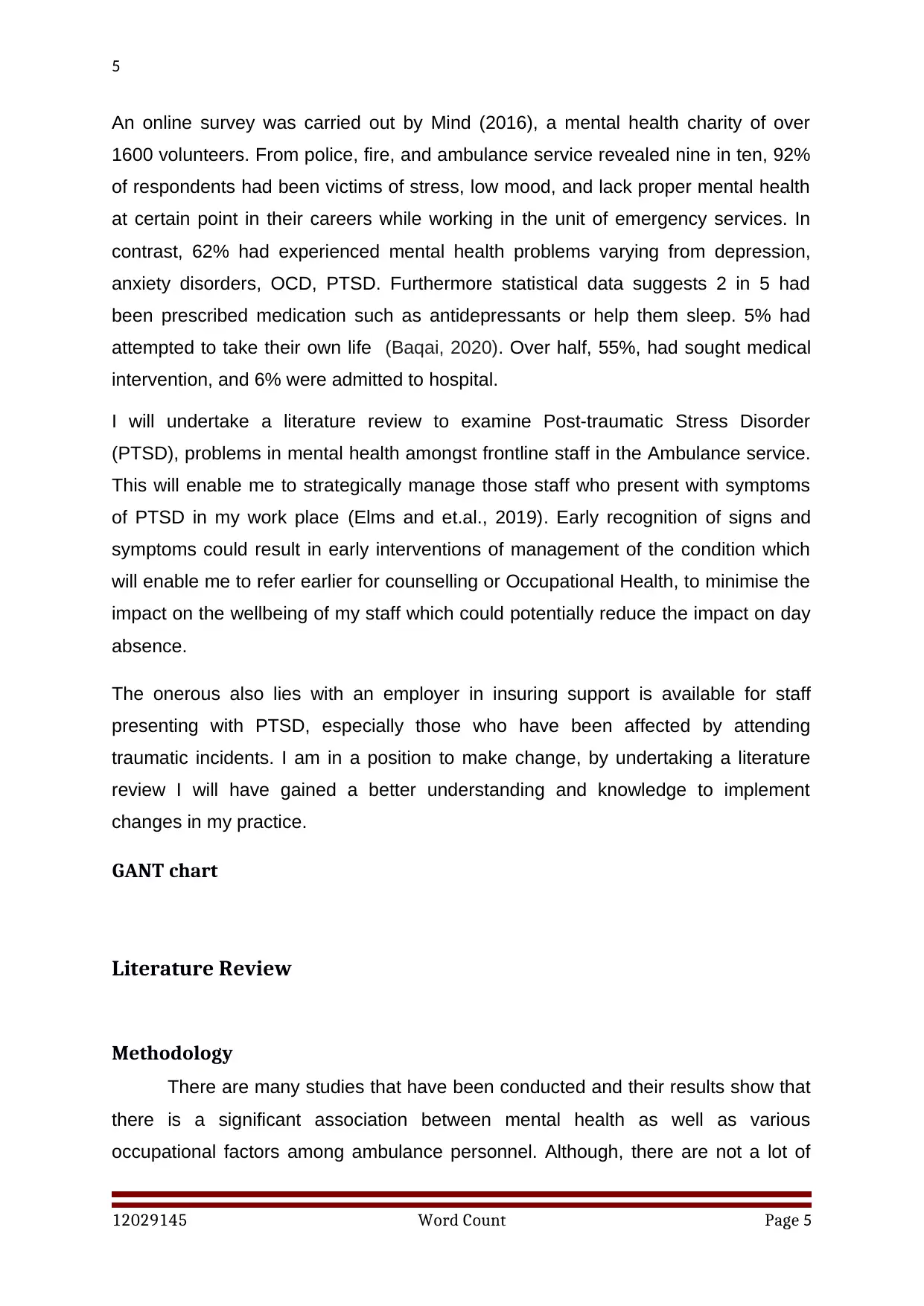
5
An online survey was carried out by Mind (2016), a mental health charity of over
1600 volunteers. From police, fire, and ambulance service revealed nine in ten, 92%
of respondents had been victims of stress, low mood, and lack proper mental health
at certain point in their careers while working in the unit of emergency services. In
contrast, 62% had experienced mental health problems varying from depression,
anxiety disorders, OCD, PTSD. Furthermore statistical data suggests 2 in 5 had
been prescribed medication such as antidepressants or help them sleep. 5% had
attempted to take their own life (Baqai, 2020). Over half, 55%, had sought medical
intervention, and 6% were admitted to hospital.
I will undertake a literature review to examine Post-traumatic Stress Disorder
(PTSD), problems in mental health amongst frontline staff in the Ambulance service.
This will enable me to strategically manage those staff who present with symptoms
of PTSD in my work place (Elms and et.al., 2019). Early recognition of signs and
symptoms could result in early interventions of management of the condition which
will enable me to refer earlier for counselling or Occupational Health, to minimise the
impact on the wellbeing of my staff which could potentially reduce the impact on day
absence.
The onerous also lies with an employer in insuring support is available for staff
presenting with PTSD, especially those who have been affected by attending
traumatic incidents. I am in a position to make change, by undertaking a literature
review I will have gained a better understanding and knowledge to implement
changes in my practice.
GANT chart
Literature Review
Methodology
There are many studies that have been conducted and their results show that
there is a significant association between mental health as well as various
occupational factors among ambulance personnel. Although, there are not a lot of
12029145 Word Count Page 5
An online survey was carried out by Mind (2016), a mental health charity of over
1600 volunteers. From police, fire, and ambulance service revealed nine in ten, 92%
of respondents had been victims of stress, low mood, and lack proper mental health
at certain point in their careers while working in the unit of emergency services. In
contrast, 62% had experienced mental health problems varying from depression,
anxiety disorders, OCD, PTSD. Furthermore statistical data suggests 2 in 5 had
been prescribed medication such as antidepressants or help them sleep. 5% had
attempted to take their own life (Baqai, 2020). Over half, 55%, had sought medical
intervention, and 6% were admitted to hospital.
I will undertake a literature review to examine Post-traumatic Stress Disorder
(PTSD), problems in mental health amongst frontline staff in the Ambulance service.
This will enable me to strategically manage those staff who present with symptoms
of PTSD in my work place (Elms and et.al., 2019). Early recognition of signs and
symptoms could result in early interventions of management of the condition which
will enable me to refer earlier for counselling or Occupational Health, to minimise the
impact on the wellbeing of my staff which could potentially reduce the impact on day
absence.
The onerous also lies with an employer in insuring support is available for staff
presenting with PTSD, especially those who have been affected by attending
traumatic incidents. I am in a position to make change, by undertaking a literature
review I will have gained a better understanding and knowledge to implement
changes in my practice.
GANT chart
Literature Review
Methodology
There are many studies that have been conducted and their results show that
there is a significant association between mental health as well as various
occupational factors among ambulance personnel. Although, there are not a lot of
12029145 Word Count Page 5
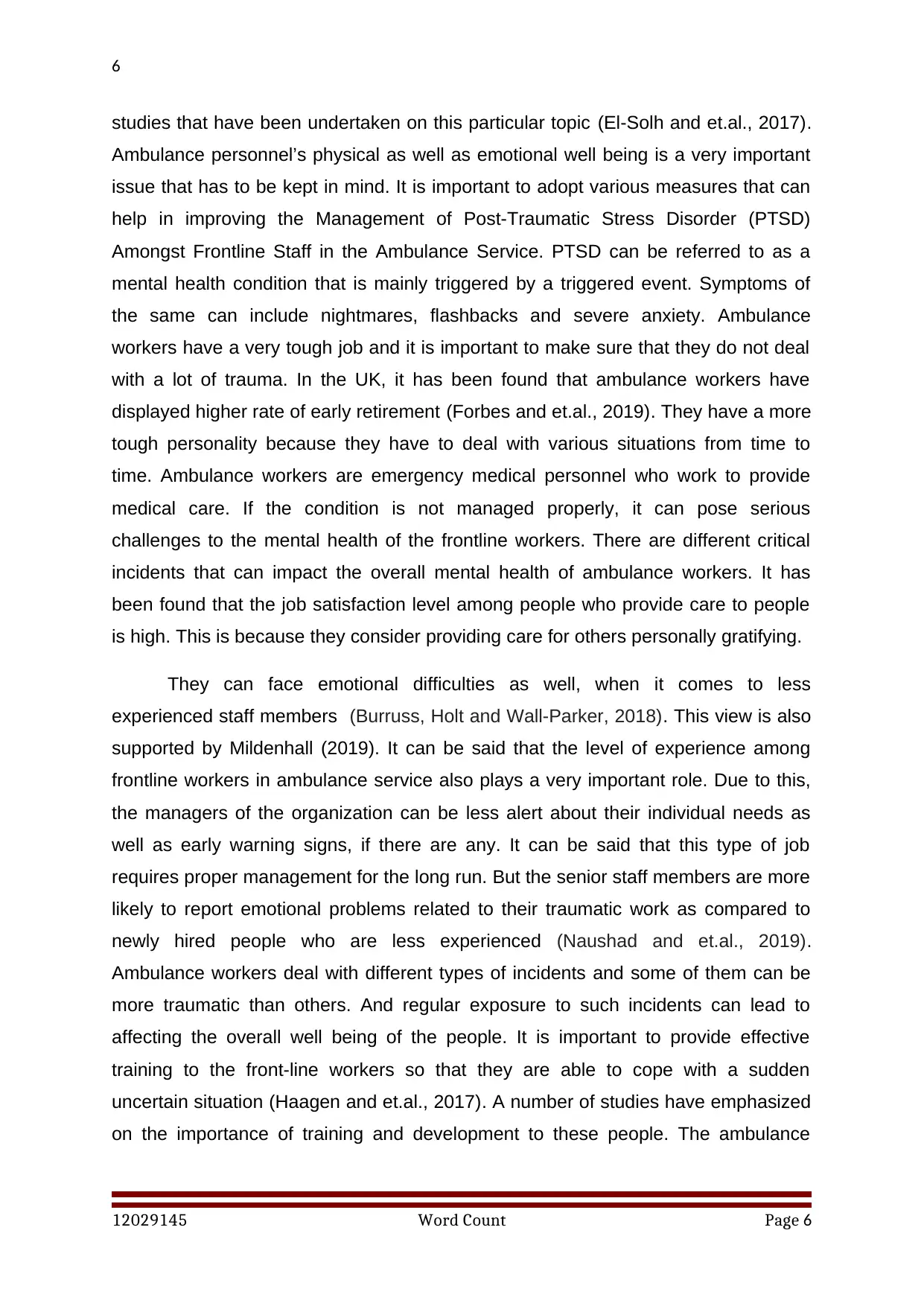
6
studies that have been undertaken on this particular topic (El-Solh and et.al., 2017).
Ambulance personnel’s physical as well as emotional well being is a very important
issue that has to be kept in mind. It is important to adopt various measures that can
help in improving the Management of Post-Traumatic Stress Disorder (PTSD)
Amongst Frontline Staff in the Ambulance Service. PTSD can be referred to as a
mental health condition that is mainly triggered by a triggered event. Symptoms of
the same can include nightmares, flashbacks and severe anxiety. Ambulance
workers have a very tough job and it is important to make sure that they do not deal
with a lot of trauma. In the UK, it has been found that ambulance workers have
displayed higher rate of early retirement (Forbes and et.al., 2019). They have a more
tough personality because they have to deal with various situations from time to
time. Ambulance workers are emergency medical personnel who work to provide
medical care. If the condition is not managed properly, it can pose serious
challenges to the mental health of the frontline workers. There are different critical
incidents that can impact the overall mental health of ambulance workers. It has
been found that the job satisfaction level among people who provide care to people
is high. This is because they consider providing care for others personally gratifying.
They can face emotional difficulties as well, when it comes to less
experienced staff members (Burruss, Holt and Wall-Parker, 2018). This view is also
supported by Mildenhall (2019). It can be said that the level of experience among
frontline workers in ambulance service also plays a very important role. Due to this,
the managers of the organization can be less alert about their individual needs as
well as early warning signs, if there are any. It can be said that this type of job
requires proper management for the long run. But the senior staff members are more
likely to report emotional problems related to their traumatic work as compared to
newly hired people who are less experienced (Naushad and et.al., 2019).
Ambulance workers deal with different types of incidents and some of them can be
more traumatic than others. And regular exposure to such incidents can lead to
affecting the overall well being of the people. It is important to provide effective
training to the front-line workers so that they are able to cope with a sudden
uncertain situation (Haagen and et.al., 2017). A number of studies have emphasized
on the importance of training and development to these people. The ambulance
12029145 Word Count Page 6
studies that have been undertaken on this particular topic (El-Solh and et.al., 2017).
Ambulance personnel’s physical as well as emotional well being is a very important
issue that has to be kept in mind. It is important to adopt various measures that can
help in improving the Management of Post-Traumatic Stress Disorder (PTSD)
Amongst Frontline Staff in the Ambulance Service. PTSD can be referred to as a
mental health condition that is mainly triggered by a triggered event. Symptoms of
the same can include nightmares, flashbacks and severe anxiety. Ambulance
workers have a very tough job and it is important to make sure that they do not deal
with a lot of trauma. In the UK, it has been found that ambulance workers have
displayed higher rate of early retirement (Forbes and et.al., 2019). They have a more
tough personality because they have to deal with various situations from time to
time. Ambulance workers are emergency medical personnel who work to provide
medical care. If the condition is not managed properly, it can pose serious
challenges to the mental health of the frontline workers. There are different critical
incidents that can impact the overall mental health of ambulance workers. It has
been found that the job satisfaction level among people who provide care to people
is high. This is because they consider providing care for others personally gratifying.
They can face emotional difficulties as well, when it comes to less
experienced staff members (Burruss, Holt and Wall-Parker, 2018). This view is also
supported by Mildenhall (2019). It can be said that the level of experience among
frontline workers in ambulance service also plays a very important role. Due to this,
the managers of the organization can be less alert about their individual needs as
well as early warning signs, if there are any. It can be said that this type of job
requires proper management for the long run. But the senior staff members are more
likely to report emotional problems related to their traumatic work as compared to
newly hired people who are less experienced (Naushad and et.al., 2019).
Ambulance workers deal with different types of incidents and some of them can be
more traumatic than others. And regular exposure to such incidents can lead to
affecting the overall well being of the people. It is important to provide effective
training to the front-line workers so that they are able to cope with a sudden
uncertain situation (Haagen and et.al., 2017). A number of studies have emphasized
on the importance of training and development to these people. The ambulance
12029145 Word Count Page 6
⊘ This is a preview!⊘
Do you want full access?
Subscribe today to unlock all pages.

Trusted by 1+ million students worldwide
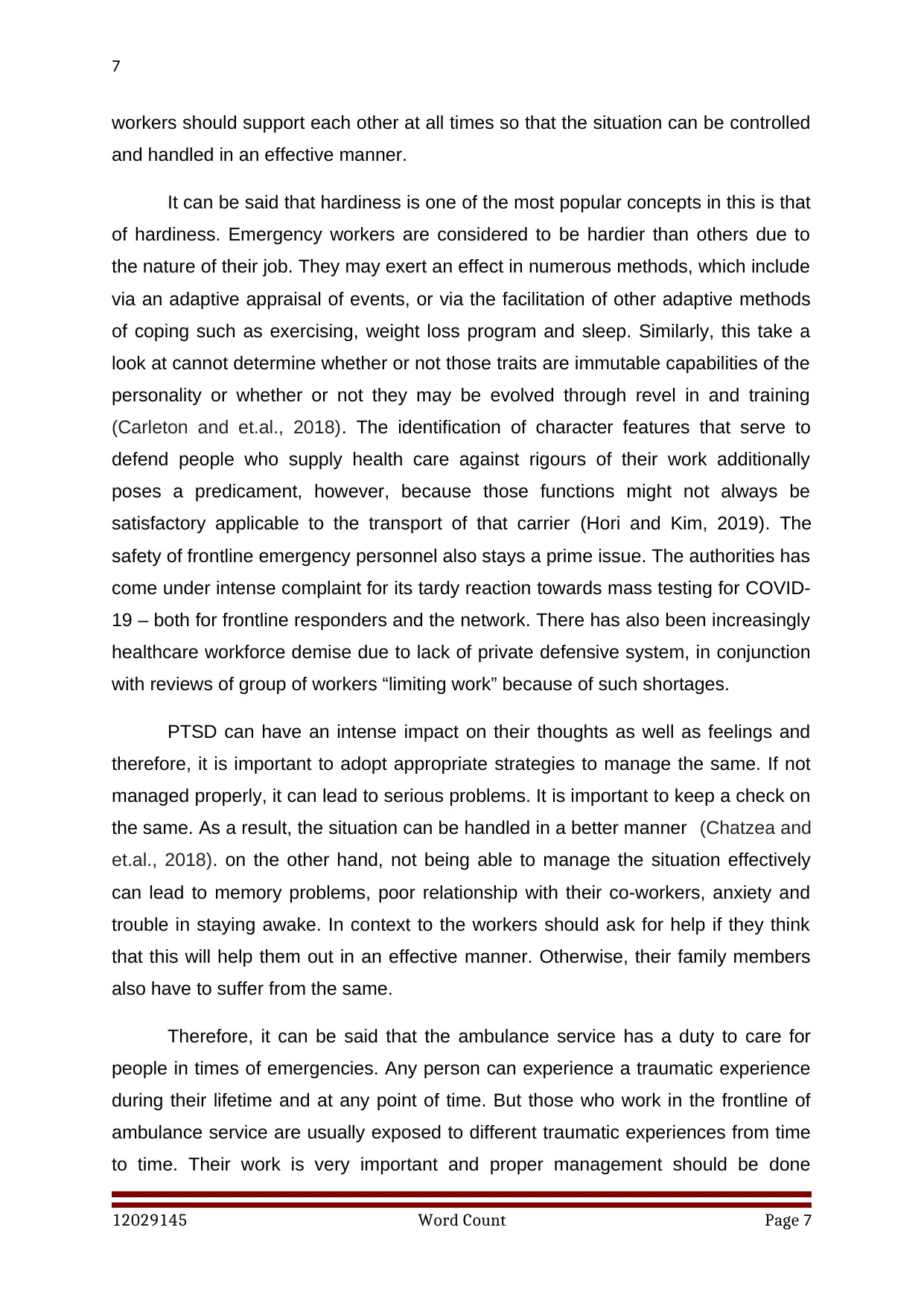
7
workers should support each other at all times so that the situation can be controlled
and handled in an effective manner.
It can be said that hardiness is one of the most popular concepts in this is that
of hardiness. Emergency workers are considered to be hardier than others due to
the nature of their job. They may exert an effect in numerous methods, which include
via an adaptive appraisal of events, or via the facilitation of other adaptive methods
of coping such as exercising, weight loss program and sleep. Similarly, this take a
look at cannot determine whether or not those traits are immutable capabilities of the
personality or whether or not they may be evolved through revel in and training
(Carleton and et.al., 2018). The identification of character features that serve to
defend people who supply health care against rigours of their work additionally
poses a predicament, however, because those functions might not always be
satisfactory applicable to the transport of that carrier (Hori and Kim, 2019). The
safety of frontline emergency personnel also stays a prime issue. The authorities has
come under intense complaint for its tardy reaction towards mass testing for COVID-
19 – both for frontline responders and the network. There has also been increasingly
healthcare workforce demise due to lack of private defensive system, in conjunction
with reviews of group of workers “limiting work” because of such shortages.
PTSD can have an intense impact on their thoughts as well as feelings and
therefore, it is important to adopt appropriate strategies to manage the same. If not
managed properly, it can lead to serious problems. It is important to keep a check on
the same. As a result, the situation can be handled in a better manner (Chatzea and
et.al., 2018). on the other hand, not being able to manage the situation effectively
can lead to memory problems, poor relationship with their co-workers, anxiety and
trouble in staying awake. In context to the workers should ask for help if they think
that this will help them out in an effective manner. Otherwise, their family members
also have to suffer from the same.
Therefore, it can be said that the ambulance service has a duty to care for
people in times of emergencies. Any person can experience a traumatic experience
during their lifetime and at any point of time. But those who work in the frontline of
ambulance service are usually exposed to different traumatic experiences from time
to time. Their work is very important and proper management should be done
12029145 Word Count Page 7
workers should support each other at all times so that the situation can be controlled
and handled in an effective manner.
It can be said that hardiness is one of the most popular concepts in this is that
of hardiness. Emergency workers are considered to be hardier than others due to
the nature of their job. They may exert an effect in numerous methods, which include
via an adaptive appraisal of events, or via the facilitation of other adaptive methods
of coping such as exercising, weight loss program and sleep. Similarly, this take a
look at cannot determine whether or not those traits are immutable capabilities of the
personality or whether or not they may be evolved through revel in and training
(Carleton and et.al., 2018). The identification of character features that serve to
defend people who supply health care against rigours of their work additionally
poses a predicament, however, because those functions might not always be
satisfactory applicable to the transport of that carrier (Hori and Kim, 2019). The
safety of frontline emergency personnel also stays a prime issue. The authorities has
come under intense complaint for its tardy reaction towards mass testing for COVID-
19 – both for frontline responders and the network. There has also been increasingly
healthcare workforce demise due to lack of private defensive system, in conjunction
with reviews of group of workers “limiting work” because of such shortages.
PTSD can have an intense impact on their thoughts as well as feelings and
therefore, it is important to adopt appropriate strategies to manage the same. If not
managed properly, it can lead to serious problems. It is important to keep a check on
the same. As a result, the situation can be handled in a better manner (Chatzea and
et.al., 2018). on the other hand, not being able to manage the situation effectively
can lead to memory problems, poor relationship with their co-workers, anxiety and
trouble in staying awake. In context to the workers should ask for help if they think
that this will help them out in an effective manner. Otherwise, their family members
also have to suffer from the same.
Therefore, it can be said that the ambulance service has a duty to care for
people in times of emergencies. Any person can experience a traumatic experience
during their lifetime and at any point of time. But those who work in the frontline of
ambulance service are usually exposed to different traumatic experiences from time
to time. Their work is very important and proper management should be done
12029145 Word Count Page 7
Paraphrase This Document
Need a fresh take? Get an instant paraphrase of this document with our AI Paraphraser
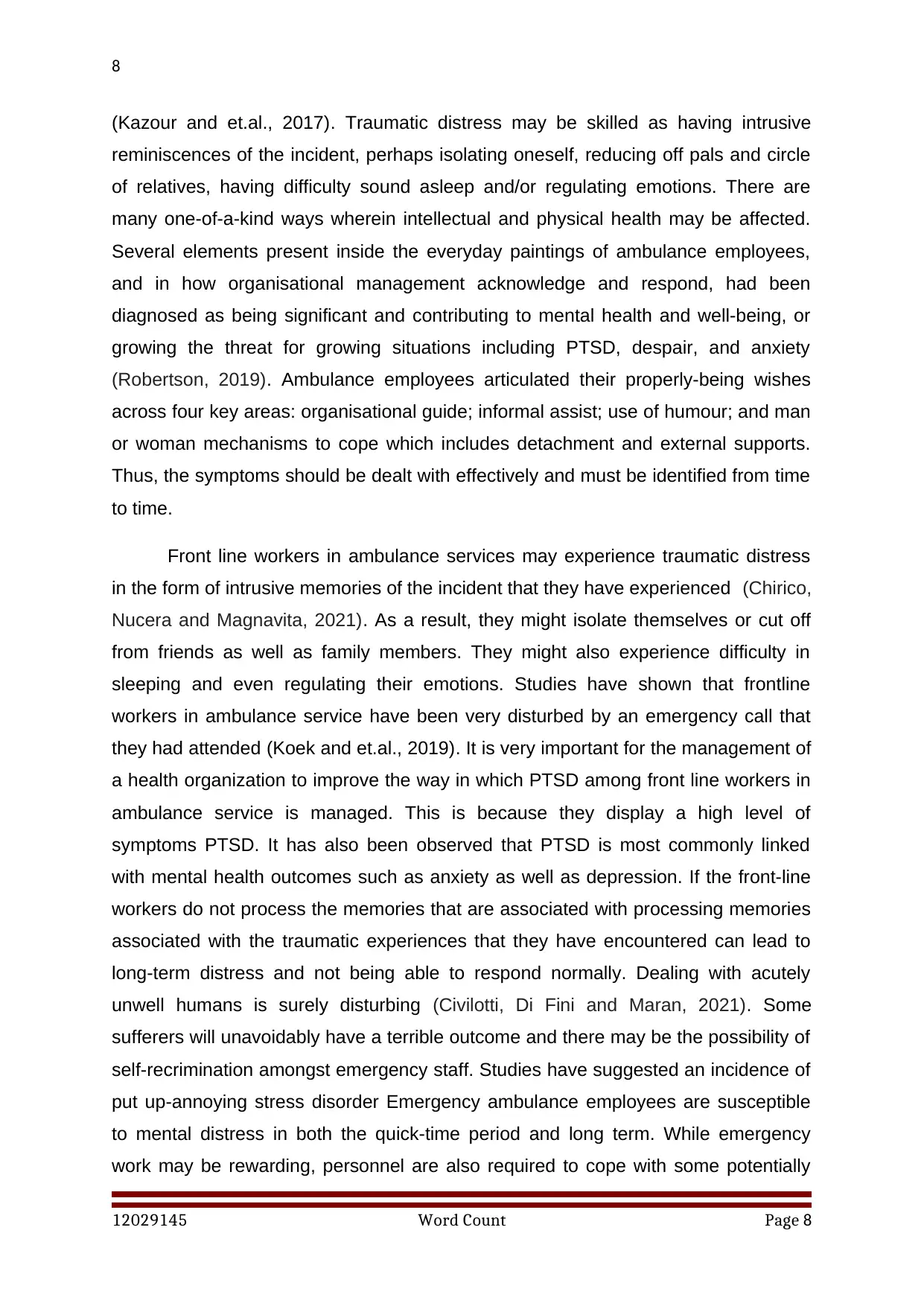
8
(Kazour and et.al., 2017). Traumatic distress may be skilled as having intrusive
reminiscences of the incident, perhaps isolating oneself, reducing off pals and circle
of relatives, having difficulty sound asleep and/or regulating emotions. There are
many one-of-a-kind ways wherein intellectual and physical health may be affected.
Several elements present inside the everyday paintings of ambulance employees,
and in how organisational management acknowledge and respond, had been
diagnosed as being significant and contributing to mental health and well-being, or
growing the threat for growing situations including PTSD, despair, and anxiety
(Robertson, 2019). Ambulance employees articulated their properly-being wishes
across four key areas: organisational guide; informal assist; use of humour; and man
or woman mechanisms to cope which includes detachment and external supports.
Thus, the symptoms should be dealt with effectively and must be identified from time
to time.
Front line workers in ambulance services may experience traumatic distress
in the form of intrusive memories of the incident that they have experienced (Chirico,
Nucera and Magnavita, 2021). As a result, they might isolate themselves or cut off
from friends as well as family members. They might also experience difficulty in
sleeping and even regulating their emotions. Studies have shown that frontline
workers in ambulance service have been very disturbed by an emergency call that
they had attended (Koek and et.al., 2019). It is very important for the management of
a health organization to improve the way in which PTSD among front line workers in
ambulance service is managed. This is because they display a high level of
symptoms PTSD. It has also been observed that PTSD is most commonly linked
with mental health outcomes such as anxiety as well as depression. If the front-line
workers do not process the memories that are associated with processing memories
associated with the traumatic experiences that they have encountered can lead to
long-term distress and not being able to respond normally. Dealing with acutely
unwell humans is surely disturbing (Civilotti, Di Fini and Maran, 2021). Some
sufferers will unavoidably have a terrible outcome and there may be the possibility of
self-recrimination amongst emergency staff. Studies have suggested an incidence of
put up-annoying stress disorder Emergency ambulance employees are susceptible
to mental distress in both the quick-time period and long term. While emergency
work may be rewarding, personnel are also required to cope with some potentially
12029145 Word Count Page 8
(Kazour and et.al., 2017). Traumatic distress may be skilled as having intrusive
reminiscences of the incident, perhaps isolating oneself, reducing off pals and circle
of relatives, having difficulty sound asleep and/or regulating emotions. There are
many one-of-a-kind ways wherein intellectual and physical health may be affected.
Several elements present inside the everyday paintings of ambulance employees,
and in how organisational management acknowledge and respond, had been
diagnosed as being significant and contributing to mental health and well-being, or
growing the threat for growing situations including PTSD, despair, and anxiety
(Robertson, 2019). Ambulance employees articulated their properly-being wishes
across four key areas: organisational guide; informal assist; use of humour; and man
or woman mechanisms to cope which includes detachment and external supports.
Thus, the symptoms should be dealt with effectively and must be identified from time
to time.
Front line workers in ambulance services may experience traumatic distress
in the form of intrusive memories of the incident that they have experienced (Chirico,
Nucera and Magnavita, 2021). As a result, they might isolate themselves or cut off
from friends as well as family members. They might also experience difficulty in
sleeping and even regulating their emotions. Studies have shown that frontline
workers in ambulance service have been very disturbed by an emergency call that
they had attended (Koek and et.al., 2019). It is very important for the management of
a health organization to improve the way in which PTSD among front line workers in
ambulance service is managed. This is because they display a high level of
symptoms PTSD. It has also been observed that PTSD is most commonly linked
with mental health outcomes such as anxiety as well as depression. If the front-line
workers do not process the memories that are associated with processing memories
associated with the traumatic experiences that they have encountered can lead to
long-term distress and not being able to respond normally. Dealing with acutely
unwell humans is surely disturbing (Civilotti, Di Fini and Maran, 2021). Some
sufferers will unavoidably have a terrible outcome and there may be the possibility of
self-recrimination amongst emergency staff. Studies have suggested an incidence of
put up-annoying stress disorder Emergency ambulance employees are susceptible
to mental distress in both the quick-time period and long term. While emergency
work may be rewarding, personnel are also required to cope with some potentially
12029145 Word Count Page 8
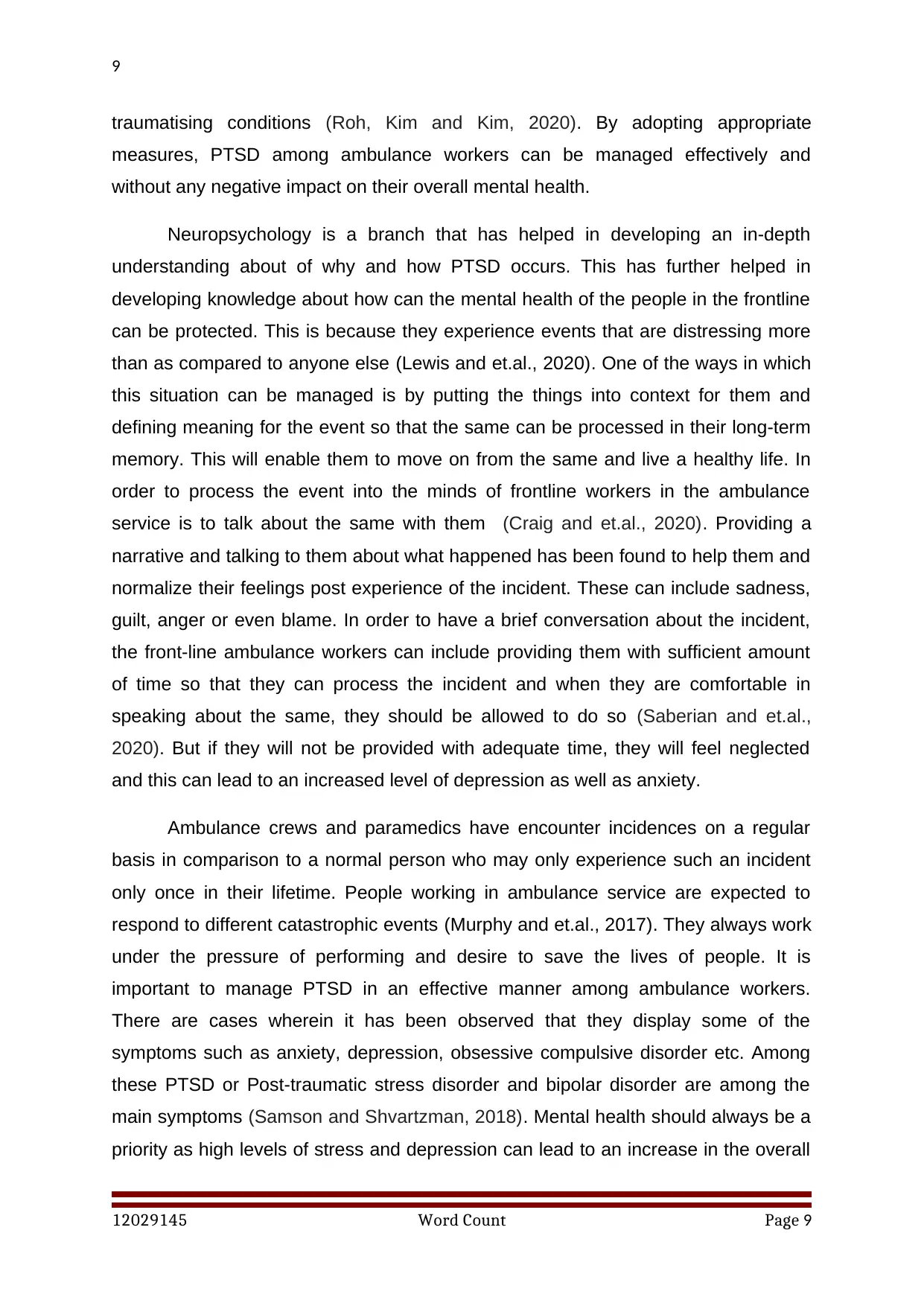
9
traumatising conditions (Roh, Kim and Kim, 2020). By adopting appropriate
measures, PTSD among ambulance workers can be managed effectively and
without any negative impact on their overall mental health.
Neuropsychology is a branch that has helped in developing an in-depth
understanding about of why and how PTSD occurs. This has further helped in
developing knowledge about how can the mental health of the people in the frontline
can be protected. This is because they experience events that are distressing more
than as compared to anyone else (Lewis and et.al., 2020). One of the ways in which
this situation can be managed is by putting the things into context for them and
defining meaning for the event so that the same can be processed in their long-term
memory. This will enable them to move on from the same and live a healthy life. In
order to process the event into the minds of frontline workers in the ambulance
service is to talk about the same with them (Craig and et.al., 2020). Providing a
narrative and talking to them about what happened has been found to help them and
normalize their feelings post experience of the incident. These can include sadness,
guilt, anger or even blame. In order to have a brief conversation about the incident,
the front-line ambulance workers can include providing them with sufficient amount
of time so that they can process the incident and when they are comfortable in
speaking about the same, they should be allowed to do so (Saberian and et.al.,
2020). But if they will not be provided with adequate time, they will feel neglected
and this can lead to an increased level of depression as well as anxiety.
Ambulance crews and paramedics have encounter incidences on a regular
basis in comparison to a normal person who may only experience such an incident
only once in their lifetime. People working in ambulance service are expected to
respond to different catastrophic events (Murphy and et.al., 2017). They always work
under the pressure of performing and desire to save the lives of people. It is
important to manage PTSD in an effective manner among ambulance workers.
There are cases wherein it has been observed that they display some of the
symptoms such as anxiety, depression, obsessive compulsive disorder etc. Among
these PTSD or Post-traumatic stress disorder and bipolar disorder are among the
main symptoms (Samson and Shvartzman, 2018). Mental health should always be a
priority as high levels of stress and depression can lead to an increase in the overall
12029145 Word Count Page 9
traumatising conditions (Roh, Kim and Kim, 2020). By adopting appropriate
measures, PTSD among ambulance workers can be managed effectively and
without any negative impact on their overall mental health.
Neuropsychology is a branch that has helped in developing an in-depth
understanding about of why and how PTSD occurs. This has further helped in
developing knowledge about how can the mental health of the people in the frontline
can be protected. This is because they experience events that are distressing more
than as compared to anyone else (Lewis and et.al., 2020). One of the ways in which
this situation can be managed is by putting the things into context for them and
defining meaning for the event so that the same can be processed in their long-term
memory. This will enable them to move on from the same and live a healthy life. In
order to process the event into the minds of frontline workers in the ambulance
service is to talk about the same with them (Craig and et.al., 2020). Providing a
narrative and talking to them about what happened has been found to help them and
normalize their feelings post experience of the incident. These can include sadness,
guilt, anger or even blame. In order to have a brief conversation about the incident,
the front-line ambulance workers can include providing them with sufficient amount
of time so that they can process the incident and when they are comfortable in
speaking about the same, they should be allowed to do so (Saberian and et.al.,
2020). But if they will not be provided with adequate time, they will feel neglected
and this can lead to an increased level of depression as well as anxiety.
Ambulance crews and paramedics have encounter incidences on a regular
basis in comparison to a normal person who may only experience such an incident
only once in their lifetime. People working in ambulance service are expected to
respond to different catastrophic events (Murphy and et.al., 2017). They always work
under the pressure of performing and desire to save the lives of people. It is
important to manage PTSD in an effective manner among ambulance workers.
There are cases wherein it has been observed that they display some of the
symptoms such as anxiety, depression, obsessive compulsive disorder etc. Among
these PTSD or Post-traumatic stress disorder and bipolar disorder are among the
main symptoms (Samson and Shvartzman, 2018). Mental health should always be a
priority as high levels of stress and depression can lead to an increase in the overall
12029145 Word Count Page 9
⊘ This is a preview!⊘
Do you want full access?
Subscribe today to unlock all pages.

Trusted by 1+ million students worldwide
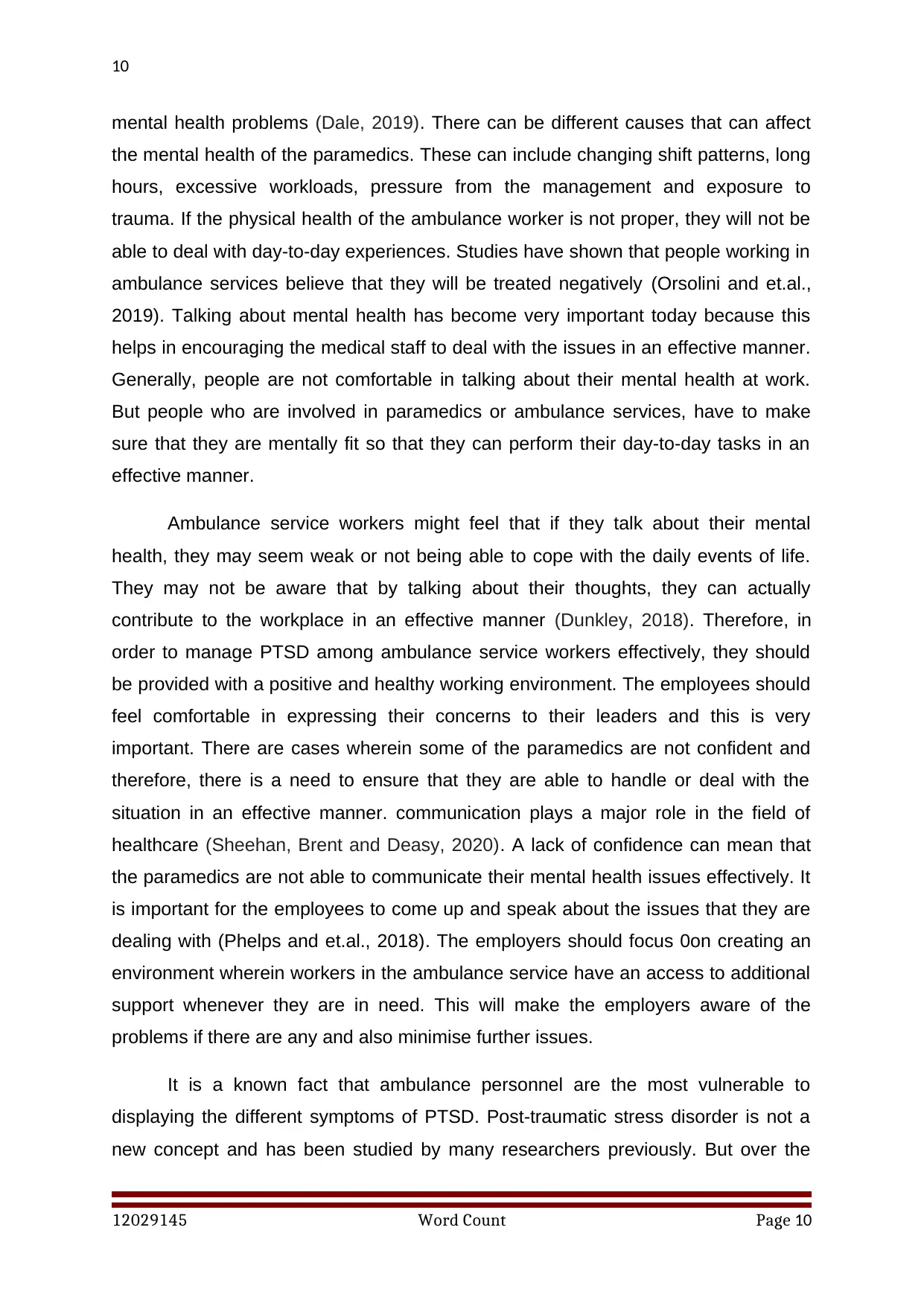
10
mental health problems (Dale, 2019). There can be different causes that can affect
the mental health of the paramedics. These can include changing shift patterns, long
hours, excessive workloads, pressure from the management and exposure to
trauma. If the physical health of the ambulance worker is not proper, they will not be
able to deal with day-to-day experiences. Studies have shown that people working in
ambulance services believe that they will be treated negatively (Orsolini and et.al.,
2019). Talking about mental health has become very important today because this
helps in encouraging the medical staff to deal with the issues in an effective manner.
Generally, people are not comfortable in talking about their mental health at work.
But people who are involved in paramedics or ambulance services, have to make
sure that they are mentally fit so that they can perform their day-to-day tasks in an
effective manner.
Ambulance service workers might feel that if they talk about their mental
health, they may seem weak or not being able to cope with the daily events of life.
They may not be aware that by talking about their thoughts, they can actually
contribute to the workplace in an effective manner (Dunkley, 2018). Therefore, in
order to manage PTSD among ambulance service workers effectively, they should
be provided with a positive and healthy working environment. The employees should
feel comfortable in expressing their concerns to their leaders and this is very
important. There are cases wherein some of the paramedics are not confident and
therefore, there is a need to ensure that they are able to handle or deal with the
situation in an effective manner. communication plays a major role in the field of
healthcare (Sheehan, Brent and Deasy, 2020). A lack of confidence can mean that
the paramedics are not able to communicate their mental health issues effectively. It
is important for the employees to come up and speak about the issues that they are
dealing with (Phelps and et.al., 2018). The employers should focus 0on creating an
environment wherein workers in the ambulance service have an access to additional
support whenever they are in need. This will make the employers aware of the
problems if there are any and also minimise further issues.
It is a known fact that ambulance personnel are the most vulnerable to
displaying the different symptoms of PTSD. Post-traumatic stress disorder is not a
new concept and has been studied by many researchers previously. But over the
12029145 Word Count Page 10
mental health problems (Dale, 2019). There can be different causes that can affect
the mental health of the paramedics. These can include changing shift patterns, long
hours, excessive workloads, pressure from the management and exposure to
trauma. If the physical health of the ambulance worker is not proper, they will not be
able to deal with day-to-day experiences. Studies have shown that people working in
ambulance services believe that they will be treated negatively (Orsolini and et.al.,
2019). Talking about mental health has become very important today because this
helps in encouraging the medical staff to deal with the issues in an effective manner.
Generally, people are not comfortable in talking about their mental health at work.
But people who are involved in paramedics or ambulance services, have to make
sure that they are mentally fit so that they can perform their day-to-day tasks in an
effective manner.
Ambulance service workers might feel that if they talk about their mental
health, they may seem weak or not being able to cope with the daily events of life.
They may not be aware that by talking about their thoughts, they can actually
contribute to the workplace in an effective manner (Dunkley, 2018). Therefore, in
order to manage PTSD among ambulance service workers effectively, they should
be provided with a positive and healthy working environment. The employees should
feel comfortable in expressing their concerns to their leaders and this is very
important. There are cases wherein some of the paramedics are not confident and
therefore, there is a need to ensure that they are able to handle or deal with the
situation in an effective manner. communication plays a major role in the field of
healthcare (Sheehan, Brent and Deasy, 2020). A lack of confidence can mean that
the paramedics are not able to communicate their mental health issues effectively. It
is important for the employees to come up and speak about the issues that they are
dealing with (Phelps and et.al., 2018). The employers should focus 0on creating an
environment wherein workers in the ambulance service have an access to additional
support whenever they are in need. This will make the employers aware of the
problems if there are any and also minimise further issues.
It is a known fact that ambulance personnel are the most vulnerable to
displaying the different symptoms of PTSD. Post-traumatic stress disorder is not a
new concept and has been studied by many researchers previously. But over the
12029145 Word Count Page 10
Paraphrase This Document
Need a fresh take? Get an instant paraphrase of this document with our AI Paraphraser
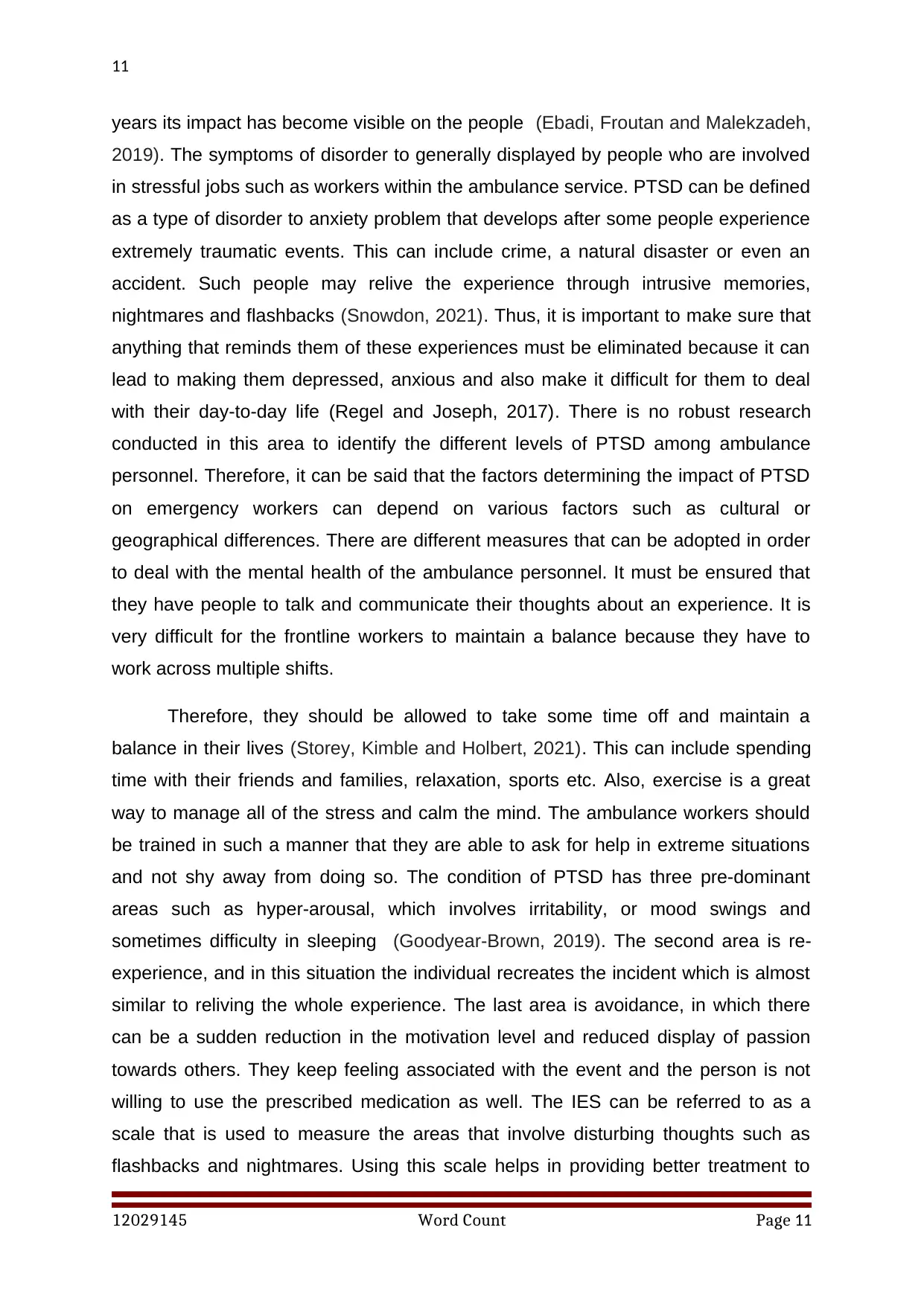
11
years its impact has become visible on the people (Ebadi, Froutan and Malekzadeh,
2019). The symptoms of disorder to generally displayed by people who are involved
in stressful jobs such as workers within the ambulance service. PTSD can be defined
as a type of disorder to anxiety problem that develops after some people experience
extremely traumatic events. This can include crime, a natural disaster or even an
accident. Such people may relive the experience through intrusive memories,
nightmares and flashbacks (Snowdon, 2021). Thus, it is important to make sure that
anything that reminds them of these experiences must be eliminated because it can
lead to making them depressed, anxious and also make it difficult for them to deal
with their day-to-day life (Regel and Joseph, 2017). There is no robust research
conducted in this area to identify the different levels of PTSD among ambulance
personnel. Therefore, it can be said that the factors determining the impact of PTSD
on emergency workers can depend on various factors such as cultural or
geographical differences. There are different measures that can be adopted in order
to deal with the mental health of the ambulance personnel. It must be ensured that
they have people to talk and communicate their thoughts about an experience. It is
very difficult for the frontline workers to maintain a balance because they have to
work across multiple shifts.
Therefore, they should be allowed to take some time off and maintain a
balance in their lives (Storey, Kimble and Holbert, 2021). This can include spending
time with their friends and families, relaxation, sports etc. Also, exercise is a great
way to manage all of the stress and calm the mind. The ambulance workers should
be trained in such a manner that they are able to ask for help in extreme situations
and not shy away from doing so. The condition of PTSD has three pre-dominant
areas such as hyper-arousal, which involves irritability, or mood swings and
sometimes difficulty in sleeping (Goodyear-Brown, 2019). The second area is re-
experience, and in this situation the individual recreates the incident which is almost
similar to reliving the whole experience. The last area is avoidance, in which there
can be a sudden reduction in the motivation level and reduced display of passion
towards others. They keep feeling associated with the event and the person is not
willing to use the prescribed medication as well. The IES can be referred to as a
scale that is used to measure the areas that involve disturbing thoughts such as
flashbacks and nightmares. Using this scale helps in providing better treatment to
12029145 Word Count Page 11
years its impact has become visible on the people (Ebadi, Froutan and Malekzadeh,
2019). The symptoms of disorder to generally displayed by people who are involved
in stressful jobs such as workers within the ambulance service. PTSD can be defined
as a type of disorder to anxiety problem that develops after some people experience
extremely traumatic events. This can include crime, a natural disaster or even an
accident. Such people may relive the experience through intrusive memories,
nightmares and flashbacks (Snowdon, 2021). Thus, it is important to make sure that
anything that reminds them of these experiences must be eliminated because it can
lead to making them depressed, anxious and also make it difficult for them to deal
with their day-to-day life (Regel and Joseph, 2017). There is no robust research
conducted in this area to identify the different levels of PTSD among ambulance
personnel. Therefore, it can be said that the factors determining the impact of PTSD
on emergency workers can depend on various factors such as cultural or
geographical differences. There are different measures that can be adopted in order
to deal with the mental health of the ambulance personnel. It must be ensured that
they have people to talk and communicate their thoughts about an experience. It is
very difficult for the frontline workers to maintain a balance because they have to
work across multiple shifts.
Therefore, they should be allowed to take some time off and maintain a
balance in their lives (Storey, Kimble and Holbert, 2021). This can include spending
time with their friends and families, relaxation, sports etc. Also, exercise is a great
way to manage all of the stress and calm the mind. The ambulance workers should
be trained in such a manner that they are able to ask for help in extreme situations
and not shy away from doing so. The condition of PTSD has three pre-dominant
areas such as hyper-arousal, which involves irritability, or mood swings and
sometimes difficulty in sleeping (Goodyear-Brown, 2019). The second area is re-
experience, and in this situation the individual recreates the incident which is almost
similar to reliving the whole experience. The last area is avoidance, in which there
can be a sudden reduction in the motivation level and reduced display of passion
towards others. They keep feeling associated with the event and the person is not
willing to use the prescribed medication as well. The IES can be referred to as a
scale that is used to measure the areas that involve disturbing thoughts such as
flashbacks and nightmares. Using this scale helps in providing better treatment to
12029145 Word Count Page 11
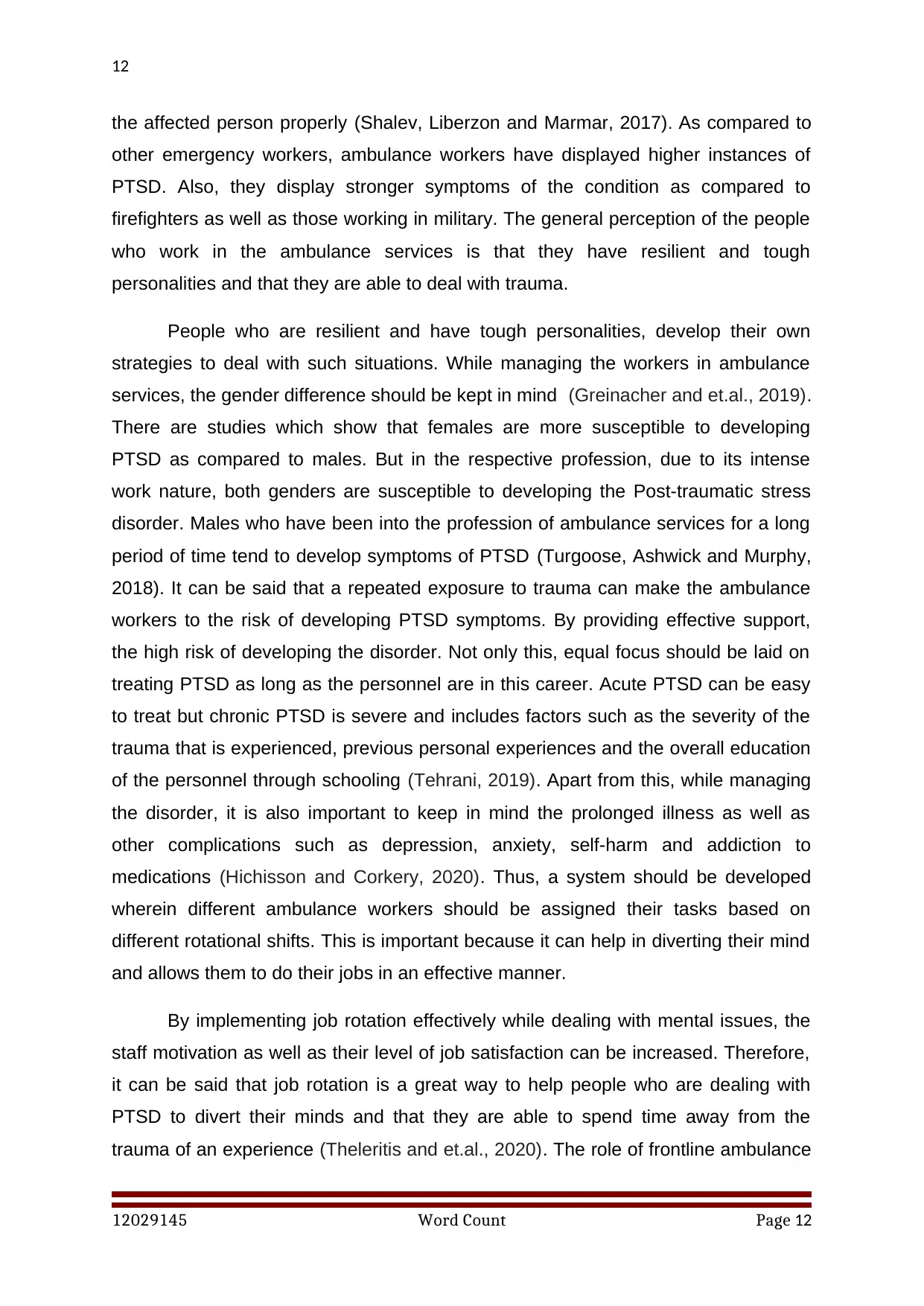
12
the affected person properly (Shalev, Liberzon and Marmar, 2017). As compared to
other emergency workers, ambulance workers have displayed higher instances of
PTSD. Also, they display stronger symptoms of the condition as compared to
firefighters as well as those working in military. The general perception of the people
who work in the ambulance services is that they have resilient and tough
personalities and that they are able to deal with trauma.
People who are resilient and have tough personalities, develop their own
strategies to deal with such situations. While managing the workers in ambulance
services, the gender difference should be kept in mind (Greinacher and et.al., 2019).
There are studies which show that females are more susceptible to developing
PTSD as compared to males. But in the respective profession, due to its intense
work nature, both genders are susceptible to developing the Post-traumatic stress
disorder. Males who have been into the profession of ambulance services for a long
period of time tend to develop symptoms of PTSD (Turgoose, Ashwick and Murphy,
2018). It can be said that a repeated exposure to trauma can make the ambulance
workers to the risk of developing PTSD symptoms. By providing effective support,
the high risk of developing the disorder. Not only this, equal focus should be laid on
treating PTSD as long as the personnel are in this career. Acute PTSD can be easy
to treat but chronic PTSD is severe and includes factors such as the severity of the
trauma that is experienced, previous personal experiences and the overall education
of the personnel through schooling (Tehrani, 2019). Apart from this, while managing
the disorder, it is also important to keep in mind the prolonged illness as well as
other complications such as depression, anxiety, self-harm and addiction to
medications (Hichisson and Corkery, 2020). Thus, a system should be developed
wherein different ambulance workers should be assigned their tasks based on
different rotational shifts. This is important because it can help in diverting their mind
and allows them to do their jobs in an effective manner.
By implementing job rotation effectively while dealing with mental issues, the
staff motivation as well as their level of job satisfaction can be increased. Therefore,
it can be said that job rotation is a great way to help people who are dealing with
PTSD to divert their minds and that they are able to spend time away from the
trauma of an experience (Theleritis and et.al., 2020). The role of frontline ambulance
12029145 Word Count Page 12
the affected person properly (Shalev, Liberzon and Marmar, 2017). As compared to
other emergency workers, ambulance workers have displayed higher instances of
PTSD. Also, they display stronger symptoms of the condition as compared to
firefighters as well as those working in military. The general perception of the people
who work in the ambulance services is that they have resilient and tough
personalities and that they are able to deal with trauma.
People who are resilient and have tough personalities, develop their own
strategies to deal with such situations. While managing the workers in ambulance
services, the gender difference should be kept in mind (Greinacher and et.al., 2019).
There are studies which show that females are more susceptible to developing
PTSD as compared to males. But in the respective profession, due to its intense
work nature, both genders are susceptible to developing the Post-traumatic stress
disorder. Males who have been into the profession of ambulance services for a long
period of time tend to develop symptoms of PTSD (Turgoose, Ashwick and Murphy,
2018). It can be said that a repeated exposure to trauma can make the ambulance
workers to the risk of developing PTSD symptoms. By providing effective support,
the high risk of developing the disorder. Not only this, equal focus should be laid on
treating PTSD as long as the personnel are in this career. Acute PTSD can be easy
to treat but chronic PTSD is severe and includes factors such as the severity of the
trauma that is experienced, previous personal experiences and the overall education
of the personnel through schooling (Tehrani, 2019). Apart from this, while managing
the disorder, it is also important to keep in mind the prolonged illness as well as
other complications such as depression, anxiety, self-harm and addiction to
medications (Hichisson and Corkery, 2020). Thus, a system should be developed
wherein different ambulance workers should be assigned their tasks based on
different rotational shifts. This is important because it can help in diverting their mind
and allows them to do their jobs in an effective manner.
By implementing job rotation effectively while dealing with mental issues, the
staff motivation as well as their level of job satisfaction can be increased. Therefore,
it can be said that job rotation is a great way to help people who are dealing with
PTSD to divert their minds and that they are able to spend time away from the
trauma of an experience (Theleritis and et.al., 2020). The role of frontline ambulance
12029145 Word Count Page 12
⊘ This is a preview!⊘
Do you want full access?
Subscribe today to unlock all pages.

Trusted by 1+ million students worldwide
1 out of 33
Your All-in-One AI-Powered Toolkit for Academic Success.
+13062052269
info@desklib.com
Available 24*7 on WhatsApp / Email
![[object Object]](/_next/static/media/star-bottom.7253800d.svg)
Unlock your academic potential
Copyright © 2020–2025 A2Z Services. All Rights Reserved. Developed and managed by ZUCOL.
